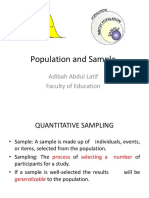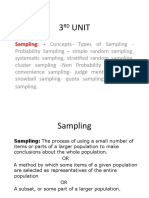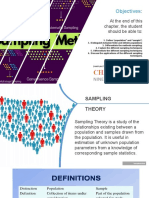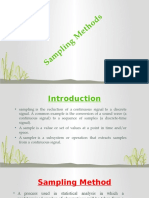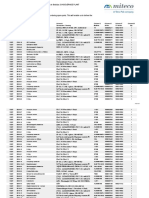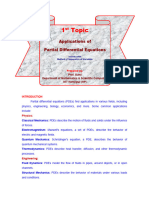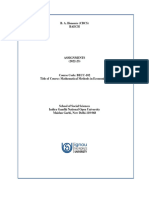Sampling and
Probability Sampling
Ernie Heredero
�Objectives
• 1. Define key concepts in sampling such as population, sampling
frame, and probability sampling.
• 2. Describe the different sampling methods.
• 3. Design a sampling procedure appropriate to quantitative research.
�Definition
• Sampling is a process of selecting cases for a study.
• Probability is the extent to which an event is likely to occur.
• Nonprobability is defined as a sampling technique in which
the researcher selects samples based on the subjective
judgment of the researcher rather than random selection.
• Probability Sampling is “the statistical process of selecting a
subset (called a sample) of a population of interest for
purposes of making observations and statistical inferences
about that population.”
�three stages in sampling process: (
• 1) defining the target population, (
• 2) choosing a sampling frame, and
• (3) choosing a sample from a sampling frame
using a well-defined sampling technique.
�• Population refers to all units of analysis with the
characteristics that one wishes to study. The unit of
analysis maybe a person, group, organization, country,
object, or any other entity that one wishes to draw
inferences.
• The sampling frame is the list from which you can draw
your sample. Usually, the list contains the accessible
section of the target population from where a sample
can be drawn.
�population
• population is “the group you want to generalize”. It consists of all the
members of the group you are interested in.
• It is important to define your population carefully and clearly.
• Examples could be all senior high school students, all men, all
Christians, etc.
�How do We Determine the sample
size for our research?
�Types of Sampling Techniques
• Probability
In probability sampling, every member of the population has an equal or
known chance of being selected. This helps in making the sample
representative of the population, which allows for generalizations and
statistical inferences.
• Non-probability
In non-probability sampling, not every individual in the population has an
equal chance of being selected. This may lead to bias, and the findings may
not be generalizable, but it can still be useful for exploratory research or
when random sampling is not feasible.
�Probability Sampling
• Simple random sampling
• Systematic Random Sampling
• Stratified Random Sampling
• Cluster Sampling
�Simple Random Sampling
• In simple random sampling (SRS), each element of the population has
an equal chance of being selected. Though it is considered as the
basic sampling method, drawing a random sample can be challenging.
The necessary tools for SRS are the complete list of all the elements in
the population and a random numbers table – a list of random
numbers which may be computer-generated. To draw a random
selection, each element of the population is assigned a number.
• For example, your target population consists of 1,000 units and you
want to draw a sample of 150. Each of the 1,000 elements must be
labelled 1-1,000. Then, from the random numbers table, we select the
corresponding label of our unit.
�Systematic Random Sampling
• In this sampling technique, a list of all elements in the population is
also prepared but instead of using random numbers table to draw the
sample, a sampling interval is used. The formula in computing for the
sampling interval is K=N/n (population size/sample size). Meaning you
select every kth element in your population list.
• K=Sampling interval
• N= total number of population
• N= desired sample size
�Stratified Random Sampling
• In stratified sampling, you divide the population into subgroups
(called strata) based on certain characteristics (like age, gender,
income, etc.). Then, you take a random sample from each subgroup.
This ensures that each subgroup is represented in your sample.
• • Example: If you want to survey students about their study habits,
and you know the students belong to different strands (e.g., STEM,
ABM, TVL)
�Stratified Random Sampling
• • What you do: Randomly select students from each section to ensure
every section is represented in your survey.
• Example: If there are 50 STEM students, 30 ABM students, and 20 TVL
students, you could take 10 students from each section. This way, you
get feedback from each academic track.
�Cluster Sampling
• In cluster sampling, you divide the population into groups (called
clusters), usually based on location or natural groupings. Then, you
randomly select entire clusters and survey all individuals within those
clusters (or randomly choose a few from within the clusters).
• For example:
You would divide the Grade 12 students into natural groups (clusters), like:
• Clusters: Different sections or classrooms.
�Cluster Sampling
• What you do: Randomly select a few entire sections (clusters) and survey all students in
those selected sections.
Example: If there are 10 Grade 12 sections, you might randomly choose 3 sections and
survey all the students from those 3 sections.
